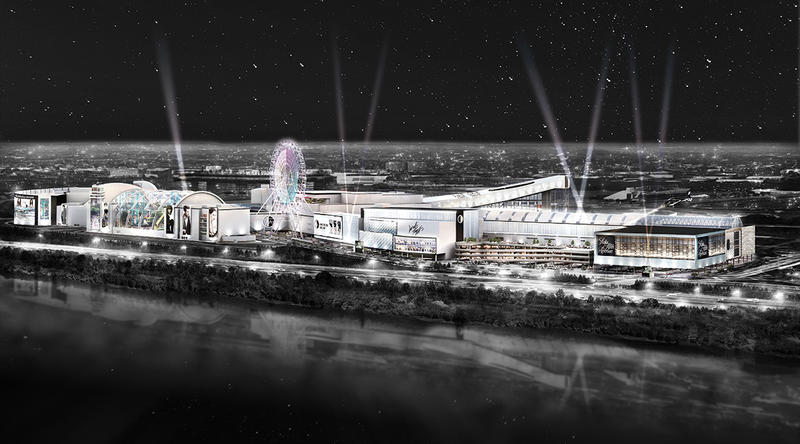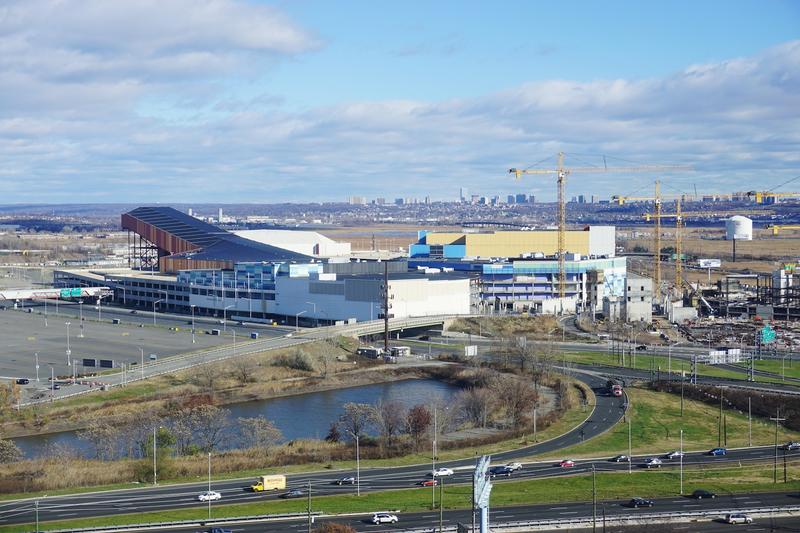If you build it, they will come—but you have to finish the sucker first.
The American Dream shopping center, located somewhere in the swamps of East Rutherford, New Jersey—and locally known as Xanadu or the Mess in the Meadowlands—has announced it will open in the fall. One can presume they mean this fall, though based on history, it’s anybody’s guess if the latest deadline will stick.
For those whose travel route doesn’t include the western spur of the Jersey Turnpike, American Dream is a massive shopping and entertainment complex located next to the football stadium where the Giants and Jets play. The place has been under construction, by various owners under various guises, since about the turn of the century. It is huge: the second-largest such complex in North America, according to its builders. It is also decidedly unattractive; former New Jersey governor Chris Christie once called it one of the ugliest buildings in America. And it is still not finished. A decade and a half after ground was broken in 2005, the mall remains under construction even as its current owners say its opening is imminent.

American Dream is a symbol of all that once was in the retailing business, a gargantuan complex housing hundreds of individual elements in what may turn out to be the high-water mark for the industry. It is also a symbol of what some say is the future of retailing in this country, with its myriad restaurants, experiential attractions and entertainment centers far outnumbering the traditional mix of stores selling merchandise. And it may well be an anachronistic symbol of what the retailing business shouldn’t be doing—creating giant complexes in the middle of a sea of parking lots for a generation that would rather curb their buying than step foot in a shopping mall.
In fact, American Dream is all of the above.
A little history: The idea of a giant shopping mall just outside New York City in the Jersey Meadowlands seemed to hold much promise, with lower sales tax and a built-in base of several sporting arenas (in addition to the football stadium, there are nearby basketball and hockey arenas, and a horse track). In 2003, the state authority overseeing the property issued a request for proposals, seeking developers to build a mall. The winning bidder was The Mills Co., which had made its name building a national network of outlet malls, including the Sawgrass Mall in southern Florida.
Mills broke ground in 2005 for what it dubbed Xanadu, perhaps (ironically) not remembering that the Coleridge epic poem about the “stately pleasure dome” was never actually finished. Indeed, the same fate awaited this modern-day Xanadu. Mills ran out of money a few years later; additional investors were brought in to shore up funding—and then the Great Recession destroyed all hope of its completion and the building sat, forlorn and forgotten, for years. (Though it was certainly not forgotten by commuters who had to look at the half-finished monstrosity every day from the Turnpike.)

Eventually, the state decided to double down, providing more funding and bringing in Triple Five, the legendary developer best known for building first the West Edmonton Mall in Canada (the largest in North America), followed by the Mall of America in Minneapolis (the largest in the United States). Certainly, Triple Five, owned and operated by the Ghermezian family, had the mall cred to finally get the job done. They quickly expanded the project, renamed it American Dream, and promised it would be open in time for the 2014 Super Bowl next door.
More than four years and at least $1 billion later, American Dream remains just that: a dream. The Ghermezians kept pushing back the opening date, and for long stretches of time it appeared as if little to no activity was taking place at the building site. As recently as last year, the family promised an April 2019 opening; now, the talk is of summer or fall, depending on which press report you believe. The complex—the developer asks that it not be called a mere “mall”—still includes an indoor ski slope, a Nickelodeon amusement park, a Ferris wheel, and enough restaurants and entertainment facilities to sate the entire population of the metropolitan New York metroplex. The developers report that more than half of the space will be devoted to non-retail businesses.
But yes, there will be stores in the 3-million-square-foot space. Saks Fifth Avenue is on the roster, giving up its spot in the nearby Short Hills Mall, long considered one of the premier retail centers in the country. Upscale stores like Hermès and Barneys will also have outposts, though many in the community surmise there is still much retail space left to lease. Triple Five has been stepping up the promotional hype recently, telling the New York Post that it will have helicopter service from Manhattan directly to the mall’s rooftop to cut travel time down to minutes. (Public transportation options for the peons are significantly more time-consuming.)
Whenever American Dream does eventually open, it will be a time capsule from an era when complexes like this dominated the shopping psyche of the American consumer. So much has changed in the past 16 years to alter the parameters of that process that the complex could easily turn out to be one of the whitest of white elephants in U.S. retailing history. At this point, even a modest success would fall far short of paying for what has become a black hole of an investment.
It’s too easy to say American Dream has turned into an American nightmare. But it’s no doubt causing many sleepless nights for all the companies that are counting on it. As Kubla Khan himself said, “All should cry, Beware! Beware!”
____________
 Warren Shoulberg is the former editor in chief for several leading B2B publications. He has been a guest lecturer at the Columbia University Graduate School of Business; received honors from the International Furnishings and Design Association and the Fashion Institute of Technology; and been cited by The Wall Street Journal, The New York Times, The Washington Post, CNN and other media as a leading industry expert. He was also a guest on the BOH podcast, and his Retail Watch columns offer deep industry insights on major markets and product categories.
Warren Shoulberg is the former editor in chief for several leading B2B publications. He has been a guest lecturer at the Columbia University Graduate School of Business; received honors from the International Furnishings and Design Association and the Fashion Institute of Technology; and been cited by The Wall Street Journal, The New York Times, The Washington Post, CNN and other media as a leading industry expert. He was also a guest on the BOH podcast, and his Retail Watch columns offer deep industry insights on major markets and product categories.



























